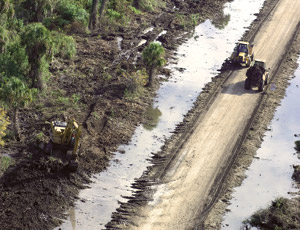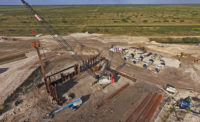The multibillion-dollar, decade-long effort to restore the Florida Everglades has made tangible but slow progress; however, the effort is facing some difficult challenges ahead, says a new report from the National Research Council.

Those challenges include finding continued funding and balancing the need for meeting federal water-quality requirements with the restoration plan’s goal of increasing water flows, the study authors conclude in the NRC’s Sept. 23 congressionally mandated progress report.
“One of the main objectives in restoring the Everglades is ‘getting the water right,’ which calls for increasing the amount of freshwater that flows through the system while meeting water-quality goals,” says Frank Davis, chairman of the committee that wrote the report and a professor at the Bren School of Environmental Science and Management at the University of California, Santa Barbara.
“But getting enough water to the right places at the right time and attaining water-quality goals throughout the entire ecosystem is proving to be more difficult and expensive than originally anticipated. It will likely take several decades and a continued commitment to systemwide pollution management, storage and water-quality treatment,” he says.
Launched in 2000, the Comprehensive Everglades Restoration Plan (CERP) is a joint federal and state program that aims to reverse the ecosystem’s decline while continuing to meet growing needs for clean water and flood control. The program consists of approximately 50 major projects to be completed over the next several decades. Florida has contributed some $2 billion thus far to the effort, and the federal government has invested approximately $700 million, including some $300 million in American Recovery and Reinvestment Act funds.
The report concludes that the program, early on beset by delays and roadblocks, is building momentum. Although all early CERP projects are behind the original schedule, some by more than a decade, the pace of implementation has improved significantly in the past two years, the report authors say. Four CERP projects are currently under construction.
Ken Ammon, deputy executive director of the South Florida Water Management District (SFWMD), says that an infusion of ARRA funds has helped accelerate key projects, most notably the one-mile Tamiami Trail project, which broke ground in December 2009. Managed by the U.S. Army Corps of Engineers, the project—though not part of the CERP—is considered a foundation of the restoration effort and will increase water flows into the Everglades National Park.
The NRC report notes the increased water flows will require additional measures to ensure water quality. That challenge will test further the SFWMD, which is trying to both meet more stringent federal limits for phosphorous—which have been reduced from 50 parts per billion to 10 ppb—and move forward with the existing CERP’s roster of projects.
“The question really is, how do we keep both of those initiatives ongoing in parallel versus only addressing one independently?” Ammon says.
The report suggests federal and state financial constraints may require a cost-effectiveness analysis to be performed “to optimize restoration outcomes.”



Post a comment to this article
Report Abusive Comment